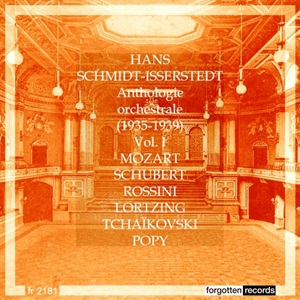
Hans Schmidt-Isserstedt
Orchestral Anthology 1935-39, Volume 1
Berlin Philharmonic Orchestra
German Opera Orchestra (Lortzing)
rec. 1935-39, Berlin
Forgotten Records FR2181 [70]
Sometimes record labels come at things from different perspectives. Eloquence’s recent two big boxes devoted to Hans Schmidt-Isserstedt’s legacy focus on the post-war Beethoven symphonic cycle, his role as accompanist and a raft of other works. In years gone by, Tahra released his 1950s Telefunken and Capitol recordings and other labels have also been hard at work restoring his discs. What Forgotten Records has done, however, is to take things right back to the beginning.
Though he had been born in Berlin, his first appointment was in Wuppertal and from 1928-31 he was in Rostock. Then Darmstadt (1931-33) and, more importantly perhaps, at the Hamburg State Opera from 1935-42 which is when he made these Telefunken recordings with the Berlin Philharmonic. His pre-war recordings were dominated by his role as accompanist to leading German violinist Georg Kulenkampff. Whether the fact that Schmidt-Isserstedt himself had studied the violin lent greater distinction to his role is debatable. What’s not debatable is the exceptionally high level of these recordings – the Beethoven, Brahms, Schumann, Mendelssohn and Spohr No 8, all of which have been multiply reissued over the years. The sequence of overtures that he recorded at the same time, though, seem to have been overlooked in the reissue market.
In fact, objectively speaking, there’s nothing truly outstanding about them. They are simply excellently polished, lively and rhythmically vivid examples of his art and very well recorded by Telefunken. He also has the advantage of having Furtwängler’s Berlin Philharmonic with one exception, the Lortzing where he directs the German Opera Orchestra. The overture recordings in this disc begin in 1935 and end in 1939. The programme is grouped by composer not chronologically which allows a tighter focus on interpretative niceties but also means that the recordings range over the years. Some sessions were slightly better recorded than others, though the standard remained conspicuously high.
He catches the swagger of the Serail, deals trenchantly with The Marriage of Figaro and responds nicely to the comic elements in the Così overture. He is affectionate in the Schubert Rosamunde, bread and butter repertoire, though with a firmly supported bass line, and is effective in the three Rossini overtures, the most popular ones in the book. He generates creditable jauntiness in the Thieving Magpie though in William Tell, fortissimi aren’t as audible as one might hope – a question of the recording. He ensures that the crisply unfolding fugato in the overture to Lortzing’s Der Waffenschmied is prominent and the orchestra is rather more prone to employing portamenti than the Berlin Philharmonic. The novelty is Francis Popy’s Suite orientale, recorded in 1935, an example of lightly spiced exotica from a composer well versed in the milieu – lingering romance, lively ‘eastern’ dances and a soupçon of Ketèlbey.
As usual with Forgotten Records there are no notes, but there are a few internet links to pursue. The cover art is the old Philharmonie c 1900. This is Volume 1, so the second volume won’t be far behind.
Jonathan Woolf
| Availability |  |
Wolfgang Amadeus Mozart (1756-1791)
The Abduction from the Seraglio, K384: Overture (1782)
The Marriage of Figaro, K492: Overture (1786)
Così fan Tutte, K588: Overture (1790)
Franz Schubert (1797-1828)
Rosamunde, Entr’acte and Ballet music, D797 (1823)
Gioachino Rossini (1792-1868)
The Thieving Magpie: Overture (1817)
William Tell: Overture (1829)
The Barber of Seville: Overture (1816)
Albert Lortzing (1801-1851)
Der Waffenschmied: Overture (1846)
Pyotr Ilych Tchaikovsky (1840-1893)
Eugene Onegin: Overture (1879)
Francis Popy (1874-1928)
Suite orientale (c. 1922)

















